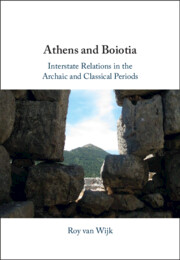85 results
Hats and titles: Maya courtier dress and hierarchy in the late Classic Maya court
-
- Journal:
- Ancient Mesoamerica , First View
- Published online by Cambridge University Press:
- 13 May 2024, pp. 1-23
-
- Article
-
- You have access
- Open access
- HTML
- Export citation
Remembering the Dead: Postmortem Guild Membership in Late Medieval England
-
- Journal:
- Journal of British Studies , First View
- Published online by Cambridge University Press:
- 26 March 2024, pp. 1-26
-
- Article
-
- You have access
- Open access
- HTML
- Export citation

Athens and Boiotia
- Interstate Relations in the Archaic and Classical Periods
-
- Published online:
- 29 February 2024
- Print publication:
- 25 January 2024
-
- Book
-
- You have access
- Open access
- Export citation
5 - Contested Memories
-
- Book:
- Athens and Boiotia
- Published online:
- 29 February 2024
- Print publication:
- 25 January 2024, pp 279-381
-
- Chapter
-
- You have access
- Open access
- HTML
- Export citation
Conclusion
-
- Book:
- Athens and Boiotia
- Published online:
- 29 February 2024
- Print publication:
- 25 January 2024, pp 382-385
-
- Chapter
-
- You have access
- Open access
- HTML
- Export citation
1 - Introduction
-
- Book:
- Athens and Boiotia
- Published online:
- 29 February 2024
- Print publication:
- 25 January 2024, pp 1-11
-
- Chapter
-
- You have access
- Open access
- HTML
- Export citation
Overcoming a stigmatic past: National Central University students in Nanjing, China, and the politics of wartime history
-
- Journal:
- Modern Asian Studies / Volume 58 / Issue 1 / January 2024
- Published online by Cambridge University Press:
- 18 March 2024, pp. 78-100
- Print publication:
- January 2024
-
- Article
- Export citation
Introduction
-
- Book:
- Shakespeare's Tercentenary
- Published online:
- 13 January 2024
- Print publication:
- 21 December 2023, pp 1-21
-
- Chapter
- Export citation
A Class of Their Own: Newspaper Obituaries and the Colonial Public Sphere in Lagos, 1880–1920
-
- Journal:
- History in Africa / Volume 50 / May 2023
- Published online by Cambridge University Press:
- 13 December 2023, pp. 99-125
-
- Article
-
- You have access
- Open access
- HTML
- Export citation

Sparta and the Commemoration of War
-
- Published online:
- 08 December 2023
- Print publication:
- 21 December 2023
Epilogue
-
- Book:
- The Jewish Imperial Imagination
- Published online:
- 08 November 2023
- Print publication:
- 09 November 2023, pp 179-192
-
- Chapter
- Export citation
Chapter 1 - Royal Shakespeare
- from Part I
-
- Book:
- Wartime Shakespeare
- Published online:
- 12 October 2023
- Print publication:
- 26 October 2023, pp 35-70
-
- Chapter
- Export citation
Chapter 14 - Commemorating the War
- from Part III - The Memory of War
-
-
- Book:
- The Cambridge Companion to British Theatre of the First World War
- Published online:
- 19 October 2023
- Print publication:
- 19 October 2023, pp 244-260
-
- Chapter
- Export citation
Chapter 13 - Re-imagining the War
- from Part III - The Memory of War
-
-
- Book:
- The Cambridge Companion to British Theatre of the First World War
- Published online:
- 19 October 2023
- Print publication:
- 19 October 2023, pp 225-243
-
- Chapter
- Export citation
COMMEMORATING CANTILUPE: THE ICONOGRAPHY OF ENGLAND’S SECOND ST THOMAS
-
- Journal:
- The Antiquaries Journal / Volume 103 / October 2023
- Published online by Cambridge University Press:
- 11 October 2023, pp. 292-314
- Print publication:
- October 2023
-
- Article
-
- You have access
- Open access
- HTML
- Export citation
Chapter 21 - Memorialisation and Biography
- from Part V - Image and Reputation
-
-
- Book:
- Puccini in Context
- Published online:
- 31 August 2023
- Print publication:
- 14 September 2023, pp 170-178
-
- Chapter
- Export citation
The “glitch” of Rabia monuments: a semiotic analysis of July 15 monuments in Turkey
-
- Journal:
- New Perspectives on Turkey / Volume 69 / November 2023
- Published online by Cambridge University Press:
- 04 September 2023, pp. 52-73
- Print publication:
- November 2023
-
- Article
- Export citation
Chapter 8 - Ellen Terry Stars at the Shakespeare Hut
-
-
- Book:
- Shakespeare at War
- Published online:
- 17 August 2023
- Print publication:
- 17 August 2023, pp 81-90
-
- Chapter
- Export citation
Chapter 9 - The 1916 Shakespeare Tercentenary at № 1 Camp in Calais
-
-
- Book:
- Shakespeare at War
- Published online:
- 17 August 2023
- Print publication:
- 17 August 2023, pp 91-100
-
- Chapter
- Export citation
BATTLING THE LION: VISUAL COMMEMORATIONS OF CRUSADE IN TWELFTH- AND THIRTEENTH-CENTURY SEALS FROM THE BRITISH ISLES
-
- Journal:
- The Antiquaries Journal / Volume 103 / October 2023
- Published online by Cambridge University Press:
- 31 July 2023, pp. 240-262
- Print publication:
- October 2023
-
- Article
- Export citation



